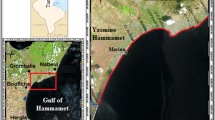Abstract
Quantification of the accumulated or eroded sediment is an important procedure towards the understanding of shoreline migration and therefore, to the evaluation of littoral dynamics. Tróia Peninsula is a sand spit, made up of dunes and beaches. It is located on the left margin of the Sado River mouth near the foot of the Arrábida Mountain, on the west coast of Portugal, 30 km south of Lisbon. Data from 1928 to 1995 clearly shows an oceanwards coastline migration during this period. The objective of this work is to quantify the volume of sediment accumulated in the NW sector of Tróia Peninsula from 1928 to 1995, a 67 years period, and determine sediments net accumulation rate for that period of time. Using the 1928 bathymetry, from a 1930 nautical chart, and the altimetry, from the 1995 Imoareia topographic survey, the volume of sediments accumulated was calculated, with a Geographic Information System. Digital Terrain Models, representing the topography and bathymetry of both years, were created for the evaluation. Results show a positive variation of 5.718.224 m3 for an area of 938.440 m2, i.e. a net sedimentation rate of approximately 85.000 m3year-1 or 0,09 myear-1.









Similar content being viewed by others
Notes
HZ defined according with local (Lisbon port) lowest spring low tide; mean port: 2h22m; mean height unit: 1.63 m.
References
Allard, J., Bertin, X., Chaumillon, E. and Pouget, F. (2008). Sand spit rhythmic development: A potential record of wave climate variations? Arçay Spit, western coast of France. Marine Geology 253(3-4):107–131
Andrade, C., Rebêlo, L., Brito, P. and Freitas, C. (2006). Processos holocénicos; Aspectos da geologia, geomorfologia e dinâmica sedimentar do troço litoral Tróia-Sines in Geologia de Portugal no contexto da Ibéria, Ed. Universidade de Évora, Portugal, pp397-418. (in Portuguese).
Brito, P., (2011). A fronteira do mar—Evolução geológica do estuário do Sado e da Plataforma Continental entre Sesimbra e o Canhão de Setúbal nos últimos ~50 000 anos. Câmara Municipal de Sesimbra, Sesimbra, 145p. (in Portuguese).
Brito, P., Andrade, C., Terrinha, P., Rebêlo, L., Monteiro, H. and Freitas, C. (2006). Variação da morfologia e volumetria do delta de vazante do estuário do Sado. 5th symposium on the Iberian Atlantic Margin Proceedings, Aveiro. (in Portuguese).
Carapuço, M. (2005). Morfodinâmica do Vértice Noroeste da Península de Tróia (Portugal); Master thesis degree from Universidade do Algarve—Faculdade de Ciências do Mar e do Ambiente, 70p. Faro, 2005. (in Portuguese).
Costa, M., Silva, R. and Vitorino, J., 2001. Contribuição para o estudo do clima de agitação marítima na costa Portuguesa, 2as Jornadas de Engenharia Costeira e Portuária. AIPCN, Aveiro, Portugal, pp. 20 p. (in Portuguese).
Dean RG, Walton TL (1975) Sediment transport processes in the vinicity of inlets with special reference to sand trapping. In: Cronin LE (ed) Estuarine Research Vol. II—Geology and Engineering. Academic, New York, pp 129–149
Ferraz, M., (2007). Identificação e caracterização das dunas e campos dunares da parte Norte da península de Tróia. Mestrado Thesis, Faculdade de Ciências da Universidade de Lisboa, Lisboa, 167 pp. (in Portuguese).
Ferraz, M., Rebêlo, L., Brito, P. and Costas, S., (2010). Evolução da parte norte da península de Tróia, VIII Congresso Nacional de Geologia. Universidade do Minho, Braga. (in Portuguese).
Gomes, N., Andrade, C.F., Carapuço, M. and Morgado, N. (2002). Dinâmica Costeira. In: Andrade, F. & Melo, J. (coords.), Estudo de Impacte Ambiental da Marina e novo Cais dos “ferries” do Tróiaresort (Península de Tróia, Setúbal), pp. 84–136. (in Portuguese).
Kullberg, M., Kullberg, J. and Terrinha, P. (2000). Tectónica da cadeia da Arrábida. Memórias de Geociências, Museu Nacional de História Natural Universidade de Lisboa 2—Tectónica das regiões de Sintra e Arrábida: 35–84. (in Portuguese).
Molinaroli E, Guerzoni S, Sarretta A, Masiol M, Pistolato M (2009) Thirty-year changes (1970 to 2000) in bathymetry and sediment texture recorded in the Lagoon of Venice sub-basins, Italy. Marine Geology 258(1–4):115–125
Nordstrom KF, Psuty N, Carter B (1990) Coastal Dunes. Form and Process. John Wiley & Sons Ltd, Chichester
Pye, K. and Wal, D.V.d., (2000). Historical trend analysis (HTA) as a tool for long-term morphological prediction in estuaries. In: Modelling estuary morphology and process, Research by the EMPHASYS Consortium to the MAFF Project FD1401. Final Report TR111, HR Wallingford, UK.
Psuty NP (1992) Spatial variation in coastal dune development. Coastal Dunes, Balkema, Rotterdam, pp 3–13
Quevauviller, P., (1985). Estuário do Sado—Costa da Galé análise geomorfológica e estudo de alguns aspectos sedimentológicos, Direcção Geral do Ordenamento. (in Portuguese).
Rebêlo L, Brito P, Monteiro H (2005) Tróia Península evolution: Foredunes as an accretion/erosion indicator. Coasts and Coastal People Scenarios of Change and Responses conference proceedings, Netherlands, p 178
Rebêlo LP, Brito P, Ferraz M (2009) Tróia Península Evolution: The Dune Morphology Record. Journal of Coastal Research, SI 56:352–355
Swift DJP, Phillips S, Thorne JA (1991) Sedimentation on continental margins IV: lithofacies and depositional systems. In: Swift DJP, Oertal GF, Tillman RW, Thorne JA (eds) Shelf sand and sandstone bodies - Geometry, facies and sequence stratigraphy. Special Publication No. 14 of the International Association of Sedimentologists ed. Blackwell Scientific Publications, Oxford, pp 89–152
Van Lancker V, Lanckneus J, Hearn S, Hoekstra P, Levoy F, Miles J, Moerkerke G, Monfort O, Whitehouse R (2004) Coastal and nearshore morphology, bedforms and sediment transport pathways at Teignmouth (UK). Continental Shelf Research 24(11):1171–1202
Acknowledgments
This work was made possible as part of the FCT and FEDER funded project EVOTRÓIA-Tróia Peninsula Evolution: Coastline and dune systems morphodynamics during the end of the Quaternary, and IMOAREIA, Sonae Turismo, which made the 1995 topography available for scientific purposes.
Author information
Authors and Affiliations
Corresponding author
Rights and permissions
About this article
Cite this article
Rebêlo, L., Ferraz, M., Brito, P. et al. Quantification of sediments accumulated in the NW sector of Tróia Peninsula (Portugal) between 1928 and 1995. J Coast Conserv 16, 261–268 (2012). https://doi.org/10.1007/s11852-011-0171-2
Received:
Revised:
Accepted:
Published:
Issue Date:
DOI: https://doi.org/10.1007/s11852-011-0171-2




